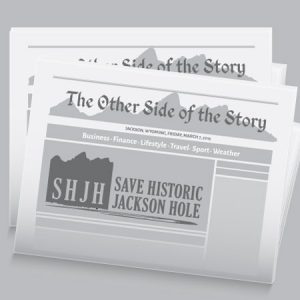
Whose future are we headed toward?
If left to their own devices, the well-intentioned folks running the town and county have shown they are incapable of slowing, or even recognizing, the out-of-control growth path we are on. Worse, if given the funds, they appear more than eager to rush hurtling toward Jackson Hole’s Brave New World.
It’s a future that former News&Guide columnist Todd Wilkinson said at the 6th Annual Wildlife Symposium will turn Jackson into Salt Lake City in less than 50 years at our current rate of growth.
It’s a future that routinely arrives sooner than our community can plan for it. An annual indicator report released this spring verified we’ve already hit and exceeded the 5% Growth Management Plan benchmark that triggers a revision of our Comp Plan. Instead, it was decided we’ll postpone another year to give time for local government to catch up with growth.
Meanwhile, the county still hasn’t addressed the most important part of its land development regulations: the Natural Resource Overlay (NRO). Similarly, the town has made little progress toward its implementation of the 2012 Comp Plan. The most vital aspect town leaders could and should address is the affordable housing mitigation rate. As gigantic new hotels sprout up in town, all local electeds can do is complain the mitigation rates are too low and their hands are tied.
Yet the town and county have found plenty of time to tackle other “important” things like trying to figure out how many millions of dollars it will take to get a bike path over Teton Pass. Or wasting weeks on the novelty of declaring Jackson a ‘sanctuary city’ by resolution.
In fact, the last thing the town managed to do to update the LDRs is to put in place zoning for strip clubs in Jackson’s Business Park zone.
Clearly, this whole growth thing is catching our electeds by surprise.
Since 2012, jobs growth is up 17%, residential growth is up 5.5%, commercial is up 4%, and lodging has increased 1.5%. Seasonal population is up by at least 90%, and more square feet of second homes has been built than workforce housing. We are creating jobs far faster than we can fill them.
We are headed in the wrong direction. Our roads are clogged, the wastewater treatment facility is close to maxed out, and the town is so full we are considering emergency camping in public parking lots that were built to address the serious lack of parking on our packed city streets.
Faced with these impending thunderheads of doom, our elected leaders have not only failed to cull a bloated list of SPET propositions, but they’ve actively campaigned for all $68.5 million worth of the taxes. Many of these SPET items will simply encourage more growth and accelerate how quickly we get to their vision of a better future.
Are these SPET items simply catching services up with growth, as our elected officials claim? Or are they examples of the institutional growth that has been one of the very causes of our overcrowding? It’s an urban spiral. More housing creates more need, which creates more building, which creates more housing need again. That’s a growth agenda that serves to increase headaches for us, sales tax revenue for government.
Remember when our elected officials claimed last fall’s general sales tax hike was not an increase in taxes because SPET would be going away? SPET not only didn’t go away but it’s back bigger than ever with 10 items that are mostly wants not needs. It’s a wish list so big, that if a true emergency (think Budge slide) comes along anytime within the next six years, we will be looking at a 7th cent of tax to add to SPET. Meanwhile our electeds are looking into an 8th cent of additional tax if they can convince state lawmakers to approve it.
It’s time to take back control of our community and steer it toward a more livable future. Somebody has to.
